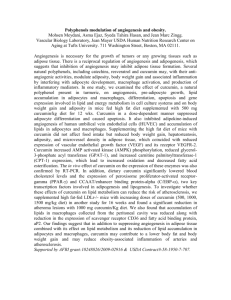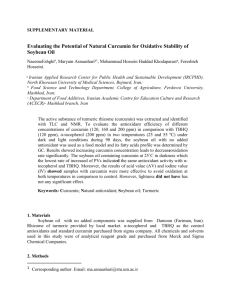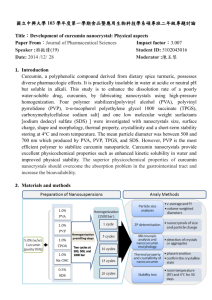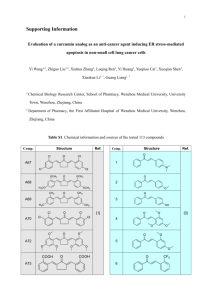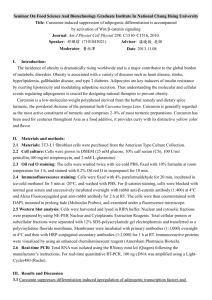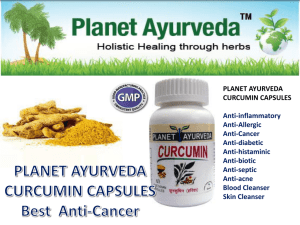2974-R - Bulgarian Chemical Communications
advertisement
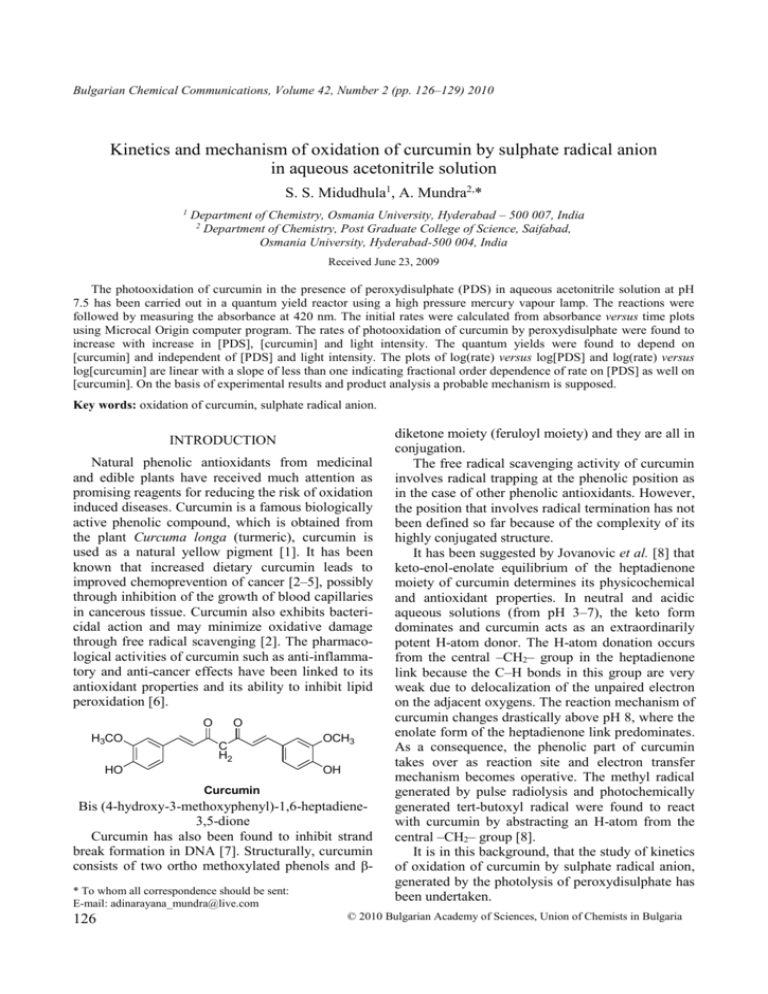
Bulgarian Chemical Communications, Volume 42, Number 2 (pp. 126–129) 2010 Kinetics and mechanism of oxidation of curcumin by sulphate radical anion in aqueous acetonitrile solution S. S. Midudhula1, A. Mundra2,* 1 Department of Chemistry, Osmania University, Hyderabad – 500 007, India 2 Department of Chemistry, Post Graduate College of Science, Saifabad, Osmania University, Hyderabad-500 004, India Received June 23, 2009 The photooxidation of curcumin in the presence of peroxydisulphate (PDS) in aqueous acetonitrile solution at pH 7.5 has been carried out in a quantum yield reactor using a high pressure mercury vapour lamp. The reactions were followed by measuring the absorbance at 420 nm. The initial rates were calculated from absorbance versus time plots using Microcal Origin computer program. The rates of photooxidation of curcumin by peroxydisulphate were found to increase with increase in [PDS], [curcumin] and light intensity. The quantum yields were found to depend on [curcumin] and independent of [PDS] and light intensity. The plots of log(rate) versus log[PDS] and log(rate) versus log[curcumin] are linear with a slope of less than one indicating fractional order dependence of rate on [PDS] as well on [curcumin]. On the basis of experimental results and product analysis a probable mechanism is supposed. Key words: oxidation of curcumin, sulphate radical anion. INTRODUCTION Natural phenolic antioxidants from medicinal and edible plants have received much attention as promising reagents for reducing the risk of oxidation induced diseases. Curcumin is a famous biologically active phenolic compound, which is obtained from the plant Curcuma longa (turmeric), curcumin is used as a natural yellow pigment [1]. It has been known that increased dietary curcumin leads to improved chemoprevention of cancer [2–5], possibly through inhibition of the growth of blood capillaries in cancerous tissue. Curcumin also exhibits bactericidal action and may minimize oxidative damage through free radical scavenging [2]. The pharmacological activities of curcumin such as anti-inflammatory and anti-cancer effects have been linked to its antioxidant properties and its ability to inhibit lipid peroxidation [6]. O H3CO O C H2 HO OCH3 OH Curcumin Bis (4-hydroxy-3-methoxyphenyl)-1,6-heptadiene3,5-dione Curcumin has also been found to inhibit strand break formation in DNA [7]. Structurally, curcumin consists of two ortho methoxylated phenols and β* To whom all correspondence should be sent: E-mail: adinarayana_mundra@live.com 126 diketone moiety (feruloyl moiety) and they are all in conjugation. The free radical scavenging activity of curcumin involves radical trapping at the phenolic position as in the case of other phenolic antioxidants. However, the position that involves radical termination has not been defined so far because of the complexity of its highly conjugated structure. It has been suggested by Jovanovic et al. [8] that keto-enol-enolate equilibrium of the heptadienone moiety of curcumin determines its physicochemical and antioxidant properties. In neutral and acidic aqueous solutions (from pH 3–7), the keto form dominates and curcumin acts as an extraordinarily potent H-atom donor. The H-atom donation occurs from the central –CH2– group in the heptadienone link because the C–H bonds in this group are very weak due to delocalization of the unpaired electron on the adjacent oxygens. The reaction mechanism of curcumin changes drastically above pH 8, where the enolate form of the heptadienone link predominates. As a consequence, the phenolic part of curcumin takes over as reaction site and electron transfer mechanism becomes operative. The methyl radical generated by pulse radiolysis and photochemically generated tert-butoxyl radical were found to react with curcumin by abstracting an H-atom from the central –CH2– group [8]. It is in this background, that the study of kinetics of oxidation of curcumin by sulphate radical anion, generated by the photolysis of peroxydisulphate has been undertaken. © 2010 Bulgarian Academy of Sciences, Union of Chemists in Bulgaria S. S. Midudhula and A. Mundra: Kinetics and mechanism of oxidation of curcumin EXPERIMENTAL Curcumin was from Sigma Chemicals, USA. and was used as received. The solution of curcumin was prepared using a HPLC grade acetonitrile and that of peroxy-disulphate with doubly distilled water. The peroxy-disulphate solution was standardized cerimetrically using ferroin indicator. The concentration of curcumin was determined by measuring the absorbance at 420 nm and from known molar absorption coefficient value at this wavelength. Irradiations were carried out in a quantum yield reactor model QYR-20 using high pressure mercury vapour lamp. In general intensity measurements were carried out using ferrioxalate actinometry. In a typical reaction, curcumin and peroxydisulphate solutions were mixed in a specially designed 1-cm path length cuvette, which is suitable both for irradiations in the reactor as well as for absorbance measurements. The absorbance measurements were carried out on a Hitachi UV-visible spectrophotometer model 3410. The progress of the reaction was followed by measuring the absorbance at the max of curcumin by interrupting irradiations at regular intervals of time (Fig. 1). The reaction rates have been calculated from the plots of absorbance versus time using a computer program. The quantum yields have been calculated from the initial rates of oxidation of curcumin and light intensity at 254 nm. This is the wavelength at which peroxydisulphate is activated to radical reac-tions. The light intensity at 254 nm was measured by peroxydisulphate actinometry. Fig. 1. Absorption spectra of photooxidation of curcumin in the presence of peroxydisulphate at different irradiation times. [curcumin] = 5.00×10–5 mol·dm–3, [PDS] = 2.00×10–4 mol·dm–3. Light intensity = 2.16×1015 photons·s–1, water-acetonitrile = 1:3 (v/v) RESULTS AND DISCUSSION Photooxidation of curcumin in presence of peroxydisulphate in aqueous-acetonitrile solution has been carried out in a quantum yield reactor using a high pressure mercury vapour lamp. The initial rates of oxidation of curcumin were measured under dif- ferent experimental conditions. The reaction rates of photooxidation of curcumin by peroxydisulphate were found to increase with increase in [PDS], [curcumin] and light intensity. The reaction order in [PDS] and [curcumin] was found to be fractional. The quantum yields were calculated from the initial rates of oxidation of curcumin and light intensity absorbed by peroxydisulphate at 254 nm. The quantum yields of the reaction have been found to depend on [curcumin] and to be independent of [PDS] and light intensity (Table 1). Jovanovic et al. [8] have studied by laser flash photolysis and pulse radiolysis, the reactions of curcumin with methyl radical and tert-butoxyl radical in acidic, neutral as well as in alkaline media. Their results clearly indicate that the H-atom donation is the preferred reaction of curcumin at pH 7 and in nonprotic solvents. Curcumin undergoes protontransfer equilibria with pKa1 = 8.55 and pKa2 = 10.41. The ionized curcumin is more water soluble and it is expected to be a better electron donor than the unionized form. On the other hand unionized curcumin may exist in the keto form and this form predominates in acidic and neutral aqueous solutions. In the keto form of curcumin, heptadienone linkage between the two methoxy phenol rings contains a highly activated carbon atom. It is obvious that the C–H bonds on this carbon should be very weak, due to delocalization of the unpaired electron on the adjacent oxygens, the radical formed by hydrogen atom donation may take the following resonance structures: It is therefore suggested that the central –CH2– group can serve as an H-atom donor in curcumin oxidations in acidic medium. It is conceivable that in the present reaction system, sulphate radical anions generated in the initiation step, react with curcumin forming curcumin radicals. These radicals are formed by an Hatom donation by curcumin to sulphate radical anion. Spectral measurements have shown that curcumin absorbs substantially at 254 nm and the molar absorption coefficient has been found to be 10255 dm3·mol–1·cm–1 at this wavelength. It is therefore possible that in the present reaction system there 127 S. S. Midudhula and A. Mundra: Kinetics and mechanism of oxidation of curcumin exists a competition between peroxydisulphate and curcumin for light absorption at 254 nm. As no photochemical change occurs in curcumin in the absence of peroxydisulphate, it is postulated that the photoexcited curcumin molecule transfers its energy to peroxydisulphate in a fast step and as a result peroxydisulphate becomes activated leading to the generation of sulphate radical anions. has been calculated using the intensity of light absorbed by peroxydisulphate at 254 nm. In view of the above discussion, the mechanism of photooxidation of curcumin in the presence of peroxydisulphate may be described by the following scheme: Table 1. Effect of [PDS], [curcumin] and light intensity on the rates and quantum yields of oxidation of curcumin by sulphate radical anion SO4– in aqueous-acetonitrile solution 1:3 (v/v). pH = 7.5, T = 300 K. [PDS]×104 [curcumin]×105 intensity×10–15 Rate×108 mol·dm–3 mol·dm–3 photons s–1 mol·dm–3s–1 2.00 4.00 8.00 10.00 4.00 4.00 4.00 4.00 5.00 5.00 5.00 5.00 5.00 5.00 5.00 2.00 1.00 0.500 0.100 5.00 5.00 5.00 2.16 2.16 2.16 2.16 2.16 2.16 2.16 2.16 2.16 2.55 3.14 2.90 5.58 9.00 10.1 4.00 2.36 1.53 0.34 6.74 8.13 10.8 2.62 2.58 2.08 2.00 0.752 0.230 0.080 0.005 2.45 2.55 2.70 The increase in quantum yield with increase in [curcumin] also supports this contention. It is likely that the excited state of curcumin is a triplet state as observed in the study of curcumin derived transients by Gorman et al. [9] who observed that laser excitation of curcumin led to the formation of triplet state with a life time of 1.5 μs. The quantum yield The curcumin radical is formed as a transient by the hydrogen atom donation from the central -CH2group of curcumin to SO4–. The curcumin radicals further combines leading to the formation of dimer. The above proposed reaction scheme receives support from spectroscopic data. The formation of dimer as the product receives support from UV-visible spectrum of the product and also from mass spectral data of the product. The UV-visible spectrum of the product dimer is similar to the one reported by Masuda et al. [10]. Formation of cur-cumin dimer is further supported by mass spectral data evidencing the molecular ion with m/z value of 734 (Fig. 2). Fig. 2. Mass spectra of curcumin dimer. 128 S. S. Midudhula and A. Mundra: Kinetics and mechanism of oxidation of curcumin REFERENCES 1. O. I. Auroma, J. Am. Oil Chem. Soc., 75, 1999 (1988). 2. N. Venkatesan, Br. J. Pharmacol., 124, 425 (1998). 3. V. Rajakrishnan, P. Viswanathan, K. N. Rajsekaran, G. Gunashekaran, V. P. Menon, Med. Sci. Res., 26, 715 (1998). 4. A. Kahfif, S. P. Schantz, T. C. Chou, D. Edelstein, P.G. Sacks, Carcinogenesis, 19, 419 (1995). 5. R. J. Anto, G. Kuttan, K. V. D. Babu, K. N. Rajsekaran, Int. J. Pharm., 131, 1 (1996). 6. E. Kuchandy, M. N. A. Rao, Int. J. Pharm., 58, 237 (1990). 7. M. Subramanian, M. N. A. Rao, P. A. T. Devasagayam, B. B. Singh, Mutation. Research., 311, 249 (1994). 8. S. V. Jovanovic, S. Steenken, W. C. Boone, M. Simic, J. Am. Chem. Soc., 121, 9677 (1999). 9. A. S. Gorman, I. Hamblett, V. S. Srinivasan, P. D. Wood, Photochem. Photobiol., 59, 389 (1994). 10. T. Masuda, K. Hidaka, A. Shinohara, T. Maeckawa, Y. Tekada, H. Yamaguch, J. Agric. Food. Chem., 47, 71 (1990). КИНЕТИКА И МЕХАНИЗЪМ НА ОКИСЛЕНИЕ НА КУРКУМИН СЪС СУЛФАТЕН АНЙОН-РАДИКАЛ ВЪВ ВОДЕН РАЗТВОР НА АЦЕТОНИТРИЛ С. С. Мидудхула1, А. Мундра2* 1 Департамент по химия, Университет на Османия, Хайдерабад 500 007, Индия 2 Департамент по химия, Колеж по науки за докторанти, Сайфабад, Университет на Османия, Хайдерабад 500 004, Индия Постъпила на 23 юни 1009 г. (Резюме) Проведено е фотоокисление на куркумин в присъствие на пероксидисулфат (ПДС) във воден разтвор на ацетонитрил при рН 7.5 в реактор за изследване на квантовия добив с използване на лампа с високо налягане на живачни пари. Реакциите са изследвани чрез измерване на абсорбцията при 420 nm. Началните скорости са изчислени с помощта на компютърна програма Микрокал Ориджин от зависимостите абсорбция-време на реакция. Намерено е, че скоростите на фотоокисление на куркумин с пероксидисулфат се увеличават с увеличаване на концентрациите на ПДС, на куркумин и интензитета на светлината. Зависимостите log(скорост)-log[ПДС] и log(скорост)-log[куркумин] са линейни с наклон по-малък от единица и показват дробен порядък на зависимостта на скоростта от концентрацията на ПДС и от концентрацията на куркумин. На основа на експерименталните резултати и анализа на продуктите е предложен вероятен механизъм на реакцията. 129
